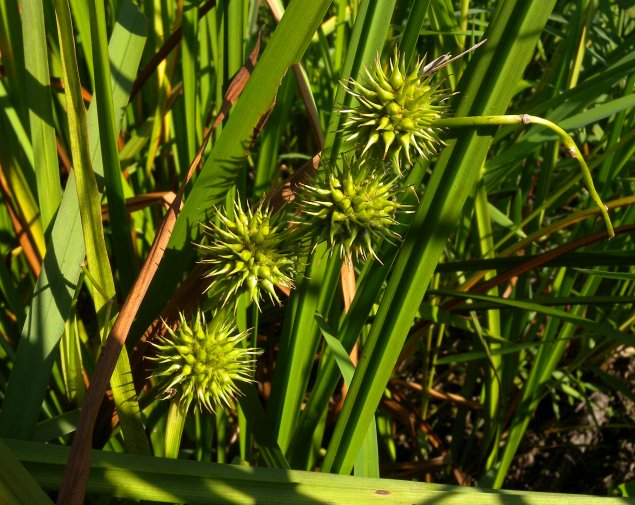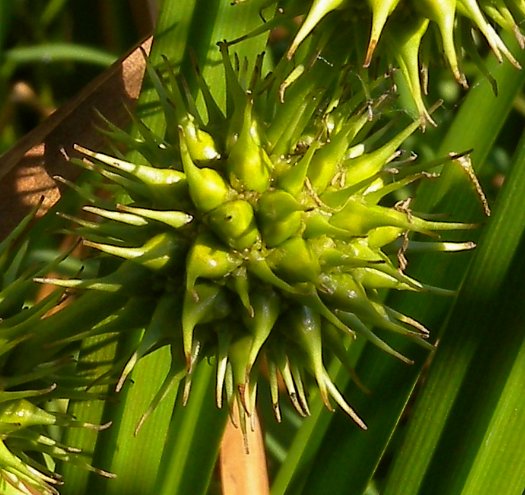Branched Bur-reed
Sparganium androcladum
Bur-reed family (Sparganiaceae)
Sparganium androcladum
Bur-reed family (Sparganiaceae)
Description:
This herbaceous plant forms a dense two-ranked cluster of alternate
leaves up to 40" (1 m.) tall; they resemble basal leaves. The leaves
are more or less erect and relatively stiff; they are 5–15 mm. across,
linear in shape, smooth along their margins,
parallel-veined, medium green, and hairless. Along the lower
half of one side of
each leaf, there is a conspicuous central keel; the bottom of each leaf
may be flattened-triangular in cross-section. Each fertile plant
produces either
a branched or unbranched inflorescence up to 30" tall that consists of
a central spike of flowers and 0–2 lateral spikes of flowers. The
central spike has 2–4 pistillate (female) flowerheads below and 3–8
staminate (male) flowers above; these flowerheads are sessile, although
the
lowest pistillate flowerhead may be short-stalked. The shorter lateral
spikes usually have no pistillate flowerheads and 1–6 staminate
flowerheads (on rare occasions, 1–2 pistillate flowerheads are
produced). Individual pistillate flowerheads are about 1–1½"
(2.5–3.5 cm.) across, globoid in shape, light green or yellowish
green,
and spiky in appearance because of the long beaks of the pistillate
flowers.

Each pistillate flower has 4 tepals that are oblong-oblanceolate in shape and a beaked ovary with a single white stigma at its tip; the tepals extend to about the midpoint of the body of the ovary. Individual staminate flowerheads are about ½–¾" across and globoid in shape; they are white-colored because of their showy filaments and anthers. The hairless stalks of the flowering spikes are light green, terete, rather stout, and tend to zigzag between the pistillate flowerheads when they are present. At the base of each spike, there is a leafy bract that is linear-lanceolate in shape, medium green, and hairless. Such bracts are shorter than the leaves. The blooming period occurs during the summer, lasting 2–3 weeks. The flowers are cross-pollinated by the wind. Afterwards, the ovaries of pistillate flowers mature into single-seeded hairless fruits, while the staminate flowers wither away and fall to the ground. Mature fruits are more brown-colored with fusiform (spindle-shaped) bodies about 5–7 mm. long that taper gradually into shiny beaks about 4–7 mm. long (9–14 mm. in length overall). These beaks can be straight or slightly curved. The detached fruits can float on water, by which means they are dispersed to new locations. The root system consists of a crown with fibrous roots; sometimes short rhizomes are produced. This plant occasionally forms colonies.

Cultivation: The preference is full or partial sun, wet conditions (including shallow water), and mucky, peaty, or sandy soil. Generally, this plant prefers wetlands with stagnant or slow-moving water.
Range & Habitat: Branched Bur-reed (Sparganium androcladum) is an uncommon plant that is widely scattered in Illinois (see Distribution Map), where it is native. It occurs mostly in the northeast quadrant of the United States (NE USA, upper and lower Midwest, central Mississippi Valley) and adjacent areas of Canada. Habitats include swamps, marshes, low areas along ponds, and sloughs. Branched Bur-reed is found in high quality natural areas.
Faunal Associations: Several semi-aquatic leaf beetles, e.g. Donacia subtilis and other Donacia spp., feed on Branched Bur-reed (Sparganium androcladum) and other bur-reeds (Sparganium spp.); they usually feed on the leaves and/or roots. Other insect feeders of these plants includes the Cattail Billbug (Sphenophorus australis), Waterlily Aphid (Rhopalosiphum nymphaeae), larvae of the Bur-reed Borer Moth (Capsula laeta), and larvae of other wetland moths (see Insect Table). The large seeds of bur-reeds are eaten by several species of ducks, including the Wood Duck, Mallard, and Ring-necked Duck. Other wetland birds that eat the seeds include the Common Coot, Sora, King Rail, and Wilson's Snipe. The Bird Table has a more complete list of these species. Finally, Muskrats readily feed on the foliage and roots of bur-reeds (Martin et al., 1951/1961; Hamerstrom & Blake, 1939).

Photographic Location: A sandy marsh at Bonnie's Prairie Nature Preserve in Iroquois County, Illinois.
Comments: Branched Bur-reed (Sparganium androcladum) is about the same size as Giant Bur-reed (Sparganium eurycarpum). It is easily distinguished from the latter species by its pistillate flowerheads, which have pistillate flowers with single white stigmas, rather than pairs of white stigmas, at the tips of the beaks. The ovary/fruits of Branched Bur-reed have bodies that are spindle-shaped, tapering gradually into long beaks, while the ovaries/fruits of Giant Bur-reed are oblanceoloid in shape, tapering abruptly into shorter beaks. Another species that Branched Bur-reed can be confused with, American Bur-reed (Sparganium americanum), differs by having slightly smaller pistillate flowerheads/seedheads (about ¾–1" across) that have dull-colored beaks and its leaves are less rigid. Unlike Branched Bur-reed, it often produces pistillate flowerheads/seedheads on lateral spikes. American Bur-reed also has an aquatic form with elongated and flexible submersed leaves; such aquatic plants don't produce flowers. American Bur-reed is more tolerant of wetland habitats with moving water than Branched Bur-reed.

Each pistillate flower has 4 tepals that are oblong-oblanceolate in shape and a beaked ovary with a single white stigma at its tip; the tepals extend to about the midpoint of the body of the ovary. Individual staminate flowerheads are about ½–¾" across and globoid in shape; they are white-colored because of their showy filaments and anthers. The hairless stalks of the flowering spikes are light green, terete, rather stout, and tend to zigzag between the pistillate flowerheads when they are present. At the base of each spike, there is a leafy bract that is linear-lanceolate in shape, medium green, and hairless. Such bracts are shorter than the leaves. The blooming period occurs during the summer, lasting 2–3 weeks. The flowers are cross-pollinated by the wind. Afterwards, the ovaries of pistillate flowers mature into single-seeded hairless fruits, while the staminate flowers wither away and fall to the ground. Mature fruits are more brown-colored with fusiform (spindle-shaped) bodies about 5–7 mm. long that taper gradually into shiny beaks about 4–7 mm. long (9–14 mm. in length overall). These beaks can be straight or slightly curved. The detached fruits can float on water, by which means they are dispersed to new locations. The root system consists of a crown with fibrous roots; sometimes short rhizomes are produced. This plant occasionally forms colonies.

Cultivation: The preference is full or partial sun, wet conditions (including shallow water), and mucky, peaty, or sandy soil. Generally, this plant prefers wetlands with stagnant or slow-moving water.
Range & Habitat: Branched Bur-reed (Sparganium androcladum) is an uncommon plant that is widely scattered in Illinois (see Distribution Map), where it is native. It occurs mostly in the northeast quadrant of the United States (NE USA, upper and lower Midwest, central Mississippi Valley) and adjacent areas of Canada. Habitats include swamps, marshes, low areas along ponds, and sloughs. Branched Bur-reed is found in high quality natural areas.
Faunal Associations: Several semi-aquatic leaf beetles, e.g. Donacia subtilis and other Donacia spp., feed on Branched Bur-reed (Sparganium androcladum) and other bur-reeds (Sparganium spp.); they usually feed on the leaves and/or roots. Other insect feeders of these plants includes the Cattail Billbug (Sphenophorus australis), Waterlily Aphid (Rhopalosiphum nymphaeae), larvae of the Bur-reed Borer Moth (Capsula laeta), and larvae of other wetland moths (see Insect Table). The large seeds of bur-reeds are eaten by several species of ducks, including the Wood Duck, Mallard, and Ring-necked Duck. Other wetland birds that eat the seeds include the Common Coot, Sora, King Rail, and Wilson's Snipe. The Bird Table has a more complete list of these species. Finally, Muskrats readily feed on the foliage and roots of bur-reeds (Martin et al., 1951/1961; Hamerstrom & Blake, 1939).

Photographic Location: A sandy marsh at Bonnie's Prairie Nature Preserve in Iroquois County, Illinois.
Comments: Branched Bur-reed (Sparganium androcladum) is about the same size as Giant Bur-reed (Sparganium eurycarpum). It is easily distinguished from the latter species by its pistillate flowerheads, which have pistillate flowers with single white stigmas, rather than pairs of white stigmas, at the tips of the beaks. The ovary/fruits of Branched Bur-reed have bodies that are spindle-shaped, tapering gradually into long beaks, while the ovaries/fruits of Giant Bur-reed are oblanceoloid in shape, tapering abruptly into shorter beaks. Another species that Branched Bur-reed can be confused with, American Bur-reed (Sparganium americanum), differs by having slightly smaller pistillate flowerheads/seedheads (about ¾–1" across) that have dull-colored beaks and its leaves are less rigid. Unlike Branched Bur-reed, it often produces pistillate flowerheads/seedheads on lateral spikes. American Bur-reed also has an aquatic form with elongated and flexible submersed leaves; such aquatic plants don't produce flowers. American Bur-reed is more tolerant of wetland habitats with moving water than Branched Bur-reed.